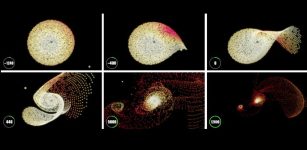Gas Giant Exoplanets Formed Earlier Than Previously Thought
Eddie Gonzales Jr. – MessageToEagle.com – Exoplanets with masses similar to Jupiter formed much sooner than previously thought, according to new research.
Image credit: NASA/JPL/USGS. Public Domain
The Ohio State University study’s results provide new information about the timing of accretion – the process of accumulating a large amount of gas as well as solid particles that are rich in carbon and oxygen to make large planets, like Jupiter.
Planets form from protoplanetary disks—spinning clouds of dust and gas ideal for planet formation. A new study suggests accretion happens early when disks are massive and younger than previously thought.
While the number of confirmed exoplanets grows, their origins and formation remain a puzzle for scientists. Initially, Jupiter-like exoplanets were thought to form in 3 to 5 million years; recent observations suggest this process takes about 1 to 2 million years.
This discovery challenges researchers’ existing theories regarding at what “age” of the protoplanetary disks these planets were formed, said Ji Wang, author of the study and an assistant professor in astronomy at Ohio State. The results could lead scientists to re-evaluate and revamp their theories of planet formation for the solar system and elsewhere.
“Everything we know about exoplanets can be put in the context of the solar system and vice versa,” said Wang in a press release.
“Usually planet formation is a bottom-up scheme, meaning it starts with small objects that build up to form a bigger planet, but that way takes time.”
Exoplanets orbit beyond our solar system, but studying their formation could provide insights into the evolution of the solar system and early Earth, which was formed after Jupiter yet significantly influenced by it.
The “bottom-up” interpretation of planetary formation is the “core accretion theory.” Another mechanism is gravitational instability, where massive clumps in a disk around a star collapse into planets. A planet’s accretion history may relate to these formation mechanisms. Wang emphasized the importance of identifying which process is more prevalent.
The study analyzed seven gas giant exoplanets with previously measured chemical properties and compared them to data on Jupiter and Saturn in our solar system.
Wang showed that the early formation of these exoplanets is consistent with recent evidence that Jupiter formed much earlier than previously thought. This finding is based on the surprisingly high amount of solids these exoplanets accreted.
All the materials accreted at the beginning of a planet’s formation increase the metallicity of its atmosphere, and by observing the traces they leave behind, researchers are able to measure the amount of solids the planet once gathered.
The higher the metallicity, the more solids and metals – anything on the periodic table more massive than hydrogen and helium – scientists can assume were accreted during the formation process, said Wang.
“We can infer that on average, every one of the five planets sampled accreted the equivalent of 50 Earth masses worth of solids,” he said. “Such a large amount of solids can only be found when a system is younger than 2 million years, but in our solar system, the total solids available is only on the order of 30 to 50 Earth masses worth.”
This new data implies that the building blocks used to form the exoplanets were available at an earlier stage of the protoplanetary disk’s evolution than once expected and their availability of these building blocks greatly decreased over a span of millions of years. Because scientists usually don’t expect to find proof that planets formed that early, it’s a finding that current theories will likely struggle to reconcile, Wang said.
“These exoplanets formed so early that there was still a large reservoir of metals available,” said Wang. “This is something that the scientific community was not fully prepared for so now they’ll have to scramble to come up with new theories to explain it.”
Gas giants significantly affect the development of rocky planets during their formation and migration. In our solar system, Jupiter and Saturn likely pushed Mercury from its original orbit and caused Mars to be smaller than Earth or Venus.
To assist astronomers with planetary formation analyses, the work offers a statistical framework for inferring solid accretion mass on exoplanets. The study highlights this as an ideal tool for examining complex elemental data.
While this research relied on archival data, Wang expects it to be complemented by new high-resolution data from more powerful astronomical observatories or next-generation technologies like the James Webb Space Telescope.
“By expanding this work with a larger sample of exoplanets, we hope to see the trend of evidence found in this paper continue to hold,” said Wang.
Written by Eddie Gonzales Jr. – MessageToEagle.com Staff Writer











